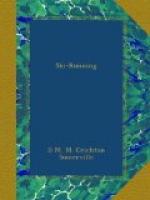Falls are often half the fun of Ski-ing, and every runner who is trying something new will sometimes fall in the endeavour. So never lose hope, however much you fall. If you have been running rather well, and then get a day when you do nothing but only means that you are stale and that your muscles and nerves need a rest. This is where the all-round Winter sportsman gains. He can spend a day on the rink or curling or tobogganing and not feel that he has wasted time.
Never scoff at people because they fall. A first-class runner is supposed to be able to run at high speed, using turns without falling. So he will, probably, if he intends to, but no first-class runner worth his salt would always run like this. He will always be trying something more difficult, turns at higher speed or in difficult snow, and consequently he will often be seen to fall, and the beginner who scoffs is merely voted an ignoramus. Here again a runner will be judged by his tracks. Look carefully at the place where he ran and try to make out what turn he was trying and what the snow was like, and why he fell. You can learn a great deal from other people’s tracks.
Falls in deep snow are always a little more risky than on hard snow, because there is greater strain on muscles and ligaments. On hard snow you get many a bump and scratch, but the results are less lasting than a torn ligament.
Having got up safely from your fall, look on the snow and see what you have dropped before starting off again. Even pockets with flaps may allow of leakage.
It is wise to tie your Rucksack firmly with a strap round your waist because, if it is loose, anything heavy inside may give you a nasty bump on the head as you fall.
TESTS
There are three British Ski tests under the Federal Council of British Ski Clubs. In addition to these, different centres and local clubs often set an elementary test for beginners in order that these may be sorted into various standards for expeditions.
Hitherto the Elementary test has usually been a run down a certain distance within a time set by the judges. This is not an altogether satisfactory test, as the beginner, who goes straight down sitting on his Skis may get through, while another, who conscientiously tries to run standing, falls the whole time and fails. Style might be judged and the sitting candidate disqualified, but when, as often happens, some seventy or eighty people enter for an Elementary test, the judges have their hands full enough with starting and timing, apart from watching individual running critically as in the 2nd-class test.
A better way, therefore, is to flag a line, which must be followed, providing traverses across slopes, which soon catch out the sitting novice.
Beginners usually hate traversing because they dislike the look of a steep slope and do not know how to prevent the instinctive pointing straight downwards of the Skis. They do not realize yet that if they would stand upright on their Skis while traversing, and lead with the upper foot while they put their weight on the lower foot and keep their whole weight somewhat on their heels, they will traverse quite easily at a gentle angle.




